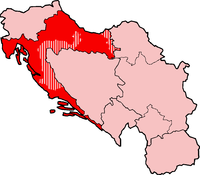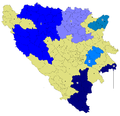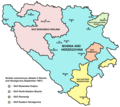
From August 1990 to November 1991, during the breakup of Yugoslavia, several Serb Autonomous Regions, Districts (literally Oblasts; sing. Serbian: Српска аутономна област (САО) / Srpska autonomna oblast (SAO)) were proclaimed in the Yugoslav republics of SR Croatia and SR Bosnia and Herzegovina in light of the possible secession of the republics from the Socialist Federal Republic of Yugoslavia. These were autonomous Serb-inhabited entities that subsequently united in their respective republic to form the Republic of Serbian Krajina in Croatia and the Republika Srpska in Bosnia and Herzegovina.
SAOs in Croatia
Main articles: SAO Krajina; SAO Eastern Slavonia, Baranja and Western Syrmia; and SAO Western Slavonia
 First map: Croatia, Yugoslavia, Serb Autonomous Regions
First map: Croatia, Yugoslavia, Serb Autonomous RegionsSecond map: Serbs of Croatia per settlement in 1981 census
The so-called anti-bureaucratic revolution of Serbian leader Slobodan Milošević aimed at strengthening of Yugoslav federal institutions triggered condemnations and separatist response in Slovenia and Croatia. This in turn provoked security dilemma among at the time numerous Serbs of Croatia community which strongly opposed any move towards Croatian independence if it will separate them from the other parts of Yugoslavia. The dilemma was rooted in historical experience of the Genocide of Serbs in the Independent State of Croatia stirred up by rising Serb and Croat nationalism. Croatian Serb political leaders of the nationalist Serb Democratic Party advocated for the partition of Croatia in case of independence which would enable Serb inhabited areas to remain in Yugoslavia.
Croatian Serb politician Jovan Rašković argued for the creation of the "integral region" by bringing together predominantly Serb municipalities in Croatia into an Association of Municipalities which would act as one of the first-level administrative units within the republic. While the Croatian legal system at the time formally permitted such a form of municipal organization the move was perceived as highly controversial and led to some of the first clashes.
The first such association was formed around the town of Knin leading to the establishment of SAO Krajina on 21 December 1990. SAO Eastern Slavonia, Baranja and Western Syrmia was formed on 25 June 1991 while SAO Western Slavonia was formed on 12 August 1991. On 19 December 1991, the SAO Krajina proclaimed itself the Republic of Serbian Krajina with SAO Western Slavonia and SAO Eastern Slavonia, Baranja and Western Syrmia joining it subsequently. At that stage the self-proclaimed autonomy was transformed into request for full independence with political leadership subsequently rejecting any autonomy proposal with notable case including Z-4 Plan. At the same time both the Government of Croatia and international mediators now contemplated peace settlements that would indeed include the establishment of some sort of predominantly Serb autonomous regions within Croatia. With the creation of new Croatian counties on 30 December 1992, the Croatian government also set aside two autonomous regions (kotar) for ethnic Serbs in the areas of Krajina known as the Autonomous District of Glina and Autonomous District of Knin. After Operation Storm, the application of the law which allowed autonomy would be temporarily suspended. In 2000 this part of the law was formally repealed.
The process of creation of the self-proclaimed Serb Autonomous Regions in Croatia included inter-ethnic clashes and violence as well as widespread ethnic cleansing of non-Serb population from the areas that those regions ended up controlling. Some of the highest ranking political and military leaders involved in this process were prosecuted by the International Criminal Tribunal for the former Yugoslavia for their direct or command responsibility for a number of war crimes committed. In the effort to preserve the peace in the region European Community limited the recognition of post-Yugoslav entities exclusively to previously established Yugoslav federal units (republics) in their administrative borders and explicitly discouraged it in case of any new secessionist region while at the same time it conditioned recognition of republics with credible minority rights guarantees. Serb Autonomous Regions in Croatia therefore failed to ever gain any formal international recognition.
SAOs in Bosnia and Herzegovina
The Serb Democratic Party established SAOs in Serb-inhabited territories. Between September–November 1991, six entities had been proclaimed. The Serbs set up their own parliament, having left the Bosnian parliament in October 1991. The Serb parliament proclaimed the "Serb Republic" (Republika Srpska) on 27 March 1992.
- SAO Bosnian Krajina, (first formed as the Autonomous Region of Krajina) in April 1991. It was the largest region, but after failure to merge with SAO Krajina in Croatia, it was renamed SAO Bosanska Krajina in September 1991.
- SAO North-Eastern Bosnia formed in September 1991; renamed SAO Semberija in November 1991, and SAO Semberija i Majevica in December 1991.
- SAO Northern Bosnia, formed in November 1991, never fully controlled its proclaimed territory.
- SAO Ozren-Posavina, planned from predominantly Bosniak and Croat municipalities in northern Bosnia, but not fully established.
- SAO Romanija, formed in September 1991, and SAO Birač, formed November 1991; combined in November 1991 as SAO Romanija-Birač.
- SAO Herzegovina (also known as SAO Eastern Herzegovina), formed in September 1991.
-
 SAOs in Bosnia and Herzegovina (Autumn 1991)
SAOs in Bosnia and Herzegovina (Autumn 1991)
-
 SAOs in Bosnia and Herzegovina (September 1991)
SAOs in Bosnia and Herzegovina (September 1991)
-
 SAOs in Bosnia and Herzegovina (November 1991)
SAOs in Bosnia and Herzegovina (November 1991)
References
- Marko Attila Hoare (2004). How Bosnia armed. Saqi Books in association with the Bosnian Institute. ISBN 978-0-86356-367-6.
- Charles W. Ingrao; Thomas A. Emmert (15 September 2012). Confronting the Yugoslav Controversies: A Scholars' Initiative. Purdue University Press. pp. 125–. ISBN 978-1-55753-617-4.
- John Oppenheim; Willem-Jan van der Wolf; Global Law Association (2003). Global war crimes tribunal collection. Global Law Association.
- ^ Hayball, Harry Jack (2015). Serbia and the Serbian rebellion in Croatia (1990-1991) (Thesis (Ph.D.)). Goldsmiths College. Retrieved 14 September 2019.
- Parliament of Croatia (3 June 1992). "Ustavni zakon o ljudskim pravima i slobodama i pravima etničkih i nacionalnih zajednica ili manjina u Republici Hrvatskoj". Narodne novine (in Croatian) (34/92). Zagreb. Archived from the original on 20 January 2015. Retrieved 7 August 2012.
- Parliament of Croatia (21 September 1995). "Ustavni zakon o privremenom neprimjenjivanju pojedinih odredbi Ustavnog zakona o ljudskim pravima i slobodama i o pravima etničkih i nacionalnih zajednica ili manjina u Republici Hrvatskoj". Narodne novine (in Croatian) (68/95). Archived from the original on 17 September 2014. Retrieved 7 August 2012.
- Parliament of Croatia (19 May 2000). "Ustavni zakon o izmjenama i dopunama Ustavnog zakona o ljudskim pravima i slobodama i o pravima etničkih i nacionalnih zajednica ili manjina u Republici Hrvatskoj". Narodne novine (in Croatian) (51/2000). Archived from the original on 20 January 2015. Retrieved 7 August 2012.
- Sioussiouras, Petros (2004). "The Prosess of Recognition of the Newly Independent States of Former Yugoslavia by the European Community: The Case of the Former Socialist Republic of Macedonia". Journal of Political & Military Sociology. 32 (1): 1–18. JSTOR 45371632.
- Nina Caspersen (15 January 2010). Contested Nationalism: Serb Elite Rivalry in Croatia and Bosnia in the 1990s. Berghahn Books. pp. 82–. ISBN 978-1-84545-791-4.
Further reading
- Stefan Grubač (1993). Srpske teme, 1989-92. ZIZ. ISBN 978-86-81883-10-5.
- Dobrica Ćosić; Ana Ćosić-Vukić (2009). Srpsko pitanje u XX veku: lična istorija jednog doba. Службени гласник. ISBN 978-86-519-0371-0.
See also
- Self-determination
- Quasi-state
- Separatism
- Polish National Territorial Region
- Autonomous Province of Western Bosnia
- Autonomous Administration of North and East Syria
- Wa State
- Autonomous regions
- History of the Serbs of Croatia
- History of the Serbs of Bosnia and Herzegovina
- Croatian War of Independence
- Bosnian War
- Serb organizations
- 1990 in Yugoslavia
- 1991 in Yugoslavia
- Political history of Republika Srpska
- Ethnic organizations based in Yugoslavia
- Serbian nationalism in Bosnia and Herzegovina
- Serbian nationalism in Croatia
- Serb Democratic Party (Bosnia and Herzegovina)
- Bosnia and Herzegovina–Croatia relations
- Politics of Yugoslavia
- Political history of Croatia
- Administrative divisions of Yugoslavia
- Former types of subdivisions of Croatia
- Former types of subdivisions of Bosnia and Herzegovina